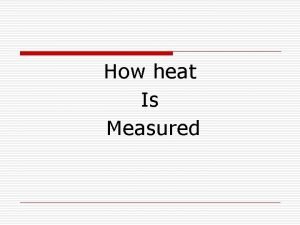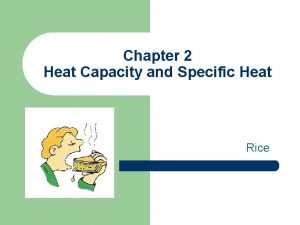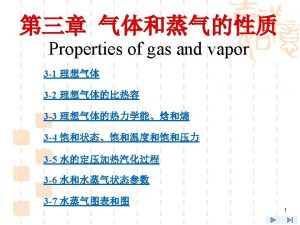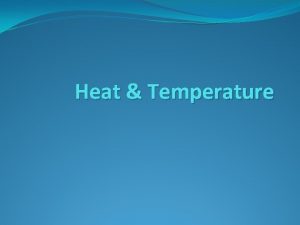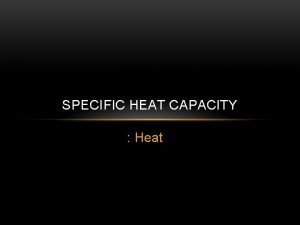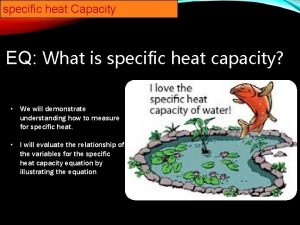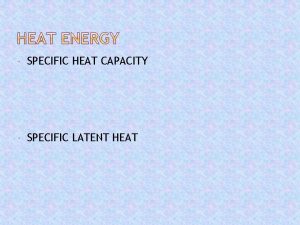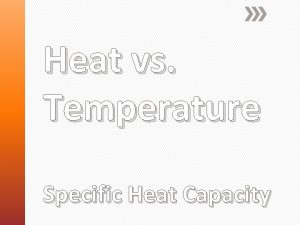Specific Heat Capacity The specific heat capacity of













- Slides: 13

Specific Heat Capacity The specific heat capacity of a material is the amount of energy needed to raise the temperature of 1 kg of the material by 1°C. Units J/kg°C.

Lesson Outcomes • State the equation for specific heat capacity. GRADE D • Use the equation for specific heat capacity to calculate energy transferred. GRADE C • Explain what it means for a material to have a high specific heat capacity. GRADE B

At the end of a sunny day at the beach, you often notice that while the sand has become quite hot, the water has stayed cool. WHY? ? ?

SAME amount of HEAT ENERGY Small TEMPERATURE RISE WATER Large TEMPERATURE RISE SAND Putting the SAME AMOUNT OF HEAT ENERGY into some materials gives a BIGGER TEMPERATURE RISE than in other materials.

A higher heat capacity means a material is able to absorb and store more heat energy. Materials vary quite widely as to the amount of heat they can absorb for the same temperature rise. Material Water Specific Heat Capacity 4200 Cooking oil 1200 Aluminium 880 Copper 380

E = mcθ energy transferred (J) mass (kg) specific heat capacity (J/kgºC) change in temperature (ºC)


A kettle contains 1. 5 kg of water at a temperature of 18ºC. How much energy is needed to bring the water to the boil? specific heat capacity of water is 4200 J/kgºC

Water has a very high specific heat capacity – this is why it is used in radiators. The higher the specific heat capacity – the more energy the substance can store.

50 k. J of energy was transferred to a material with a mass of 5 kg. The temperature increased from 20ºC to 60ºC. What is the specific heat capacity of the material?

Lesson Outcomes • State the equation for specific heat capacity. GRADE D • Use the equation for specific heat capacity to calculate energy transferred. GRADE C • Explain what it means for a material to have a high specific heat capacity. GRADE B


SPECIFIC HEAT CAPACITIES Air (typical room conditions) 1012 Lead 129 Aluminium 897 Mercury 139. 5 Carbon dioxide 839 Methane 2191 Chromium 449 Nitrogen 1040 Copper 385 Neon 1030. 1 Diamond 509. 1 Oxygen 918 Ethanol 2440 Paraffin wax 2500 Gasoline 2220 Polyethylene 2302. 7 Glass 840 Gold 129 Silica 703 Granite 790 Water at 100 °C (steam) 2080 Graphite 710 Water at 25 °C 4181. 3 Helium 5193. 2 Water at − 10 °C (ice) 2050 Hydrogen 14300 Zinc 387 Iron 450
 Specific heat capacity graph
Specific heat capacity graph How to find the specific heat capacity
How to find the specific heat capacity Specific heat capacity
Specific heat capacity Specific heat capacity of water
Specific heat capacity of water Specific heat capacity calculator
Specific heat capacity calculator Specific heat capacity of ice cream
Specific heat capacity of ice cream Specific heat chart
Specific heat chart Specific heat capacity of rice
Specific heat capacity of rice Constant pressure specific heat capacity
Constant pressure specific heat capacity Measure thermal energy
Measure thermal energy Specific heat capacity equation with power
Specific heat capacity equation with power Specific heat enthalpy equation
Specific heat enthalpy equation Symbol of specific heat capacity
Symbol of specific heat capacity What is specific heat capacity
What is specific heat capacity

